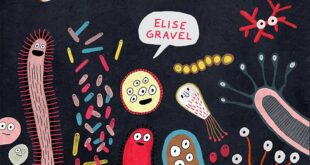The Peanutbutter Sisters and Other American Stories by Rumi Hara from Drawn & Quarterly is slippery when it comes to genre. Once readers think they understand where it would fit on the bookshelf, the stories smile and sneak away like a fading dream only to reappear somewhere unexpected. Hara’s previous work, Nori, also slipped in and out of the fields of dreams. This new anthology gives Hara room to play with several stories, each their own universe.

The lead story “The Peanutbutter Sisters” takes great brushstrokes of magical realism. The magical aspect is obvious as the story shows three sisters, Mississippi, Georgia, and Alabama, with the surname “Peanutbutter,” all names from their father’s efforts to “belong to a land.” Junk-resellers by trade, they vacation by riding hurricanes up the East Coast. Commentary from reality bleeds into even the bounds of magic as the narrator notes that hurricanes seem to be going farther and farther as years go on. She also laments how difficult it is to find a vacant whale to hitchhike home upon as the ocean becomes clogged with trash. The girls are forced to find rides from humans to get home, leading to a whole series of unexpected adventures.
The other stories in the collection run the gamut from magical to realism. Some are very real, such as “Walking with Tammy Tabata,” where two students discuss possibilities for writing a Noh play for course credit, discussing the narrative aspects of Noh woven scarcely realizing how similar they are to their own tale. Other stories are wildly magical, like “Tree Love” about tree-headed people whose branches blossom with love and two girls facing off to blow the most titanic bubble in “Bubblegum Fighters.”
The genre range even dips into science fiction in “Living Things” about a journalist covering a cross-country race in a world where journalists are seen as outdated (“Can’t they just send a drone?”) and personal conveyances require special legal status. Interspersed between the tales are drawings of “The Builders,” monkey-like people who work wordlessly to fell trees, process the timber, and build a spectacular new home in a surreal world.
Hara’s art throughout The Peanutbutter Sisters and Other American Stories ebbs and flows in sync with the genre-defying nature of each tale. The black and white of the stories are a betrayal of simplicity with the myriad of textures and shadows that give the worlds their depth. Characters follow a strong influence of Japanese artists such as Kuniko Tsurita but with a gentler, though not cartoony, take on many of the expressions.
“The Builders” drawings are especially intricate with wide splotches of paint added for yet more texture, not to mention the additions of colors in flowers, creatures, and astronomical objects. Their world seems as complex as those of Hieronymus Bosch. The black-and-white mundane and the watercolor magical come together most strikingly in “Bombadonna,” the tale of a mystical entity pointing where bomb-headed women should run to blow things up, opening up space for new construction. It, perhaps best of all, shows how the magical and the real live in symbiosis to make something altogether new.
 Blogcritics The critical lens on today's culture & entertainment
Blogcritics The critical lens on today's culture & entertainment




